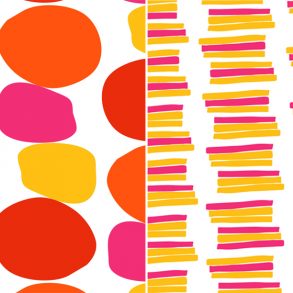Each month in The Textile Design Lab we welcome an industry expert who offers training in their area of expertise. This month we are thrilled to have Petri Juslin, the Artwork Studio Manager for Marimekko, and an expert in fabric printing.
“I came to work in Marimekko’s printing factory when I was 23, this was in spring 1986. I learned a lot of screen making and printing, and soon worked in the artwork studio. From the beginning of 1989 I was pretty much responsible for making the designs printable. At that time there were no computers in this process. I learned the traditional methods.” You can learn more about Petri in our interview from earlier this month.
Today we are pleased to share this excerpt from Petri’s full 23 page training on fabric printing, in which you’ll learn some of the most important factors to think about when designing for the wet printing process, to insure the most beautiful end result on fabric.
Introduction to Fabric Printing
In my work I often see nice pattern designs that may be well repeated, but in which I cannot see that the “designer” has given much thought to how it would be printed and on what kind of material. These particular patterns may be nice illustrations, but I think the “design” concept should include an idea of how the possibilities of production are being utilized in the construction. For example, in textile design it is important that you can create different colorways with the same screens. This is kind of a core idea in textile screen printing.
Some students and designers are tempted to skip these questions by saying “it can always be printed digitally”. But in digital textile printing there are also many restrictions – when you think of material, color fastness requirements or price.
Naturally you can and should question limitations. Personally as a prepress and printing professional I think designers who explore the limits of what is possible inspire me the most to develop techniques serving these ideas. We all love challenges, but just to achieve one thing, no one wants to compromise too much with everything else.
I am often asked to brief new designers on “all the limitations”. I tend to say that I would rather talk about possibilities. In fact, they are often the two sides of the same coin. Of course you can never be aware of all the technical specifications of the printing process. Because of this the printer has its own prepress department to prepare the screen files with suitable trapping and measures for their production. But you should be aware of what they need to do, because they may have to do things that ruin your design if you have not given the production process much thought.
Registration
Registration – The alignment of one color of artwork with another. Multi color prints require the different colors of the artwork to line up correctly in relation to one another.
http://www.catspitproductionsllc.com/screen-printing-glossary.html
All in all screen printing is not very accurate in registration for several reasons.
1. Big flat screens are often unstable because of the large frame and also because the tension of the screen fabric stretched on it tends to lessen through use.
2. No matter how well the fabric is attached to the printing table it will begin to shrink and move a bit as soon as it receives the first screenful of wet printing dye. And when you place the next screen on top of that pattern, the shape of it on the fabric is not exactly the same as on the screen anymore. I hope you have an opportunity to do some multicolor hand printing with small screens. That gives you a pretty good idea of the challenges. Also in machine printing the screens are being adjusted to registration by human eyes and hands.
Trapping
Trap – Color art separations where the edges of the different colors overlap one another slightly.
http://www.catspitproductionsllc.com/screen-printing-glossary.html)
Trapping is used to compensate for the imperfect registration. This can be done by creating an overlapping between two colors next to each other which allows a little movement without revealing white space in between them. This always has to be done when we are using so called direct printing methods – that is when all the colors including background color are printed with screens.
Because most textile printing dyes are translucent and create mixed tones when overlapping, except some very opaque pigment pastes, you have to consider the tone created with trapping. Opposite colors create very dark and often dirty looking tones and even a small overlapping of for instance red and green create a very dark contour to the shape of your image. This could totally ruin your idea of the design – or it could give it a nice touch, if you designed that…
You can access the full training and all of our Textile Design Lab courses and members-only content by joining today. Next month we will be welcoming Sarah Grubbs, Lead Graphic Designer for Nike Swim, as our guest expert.














